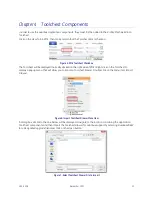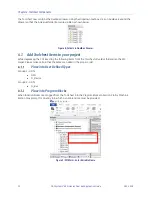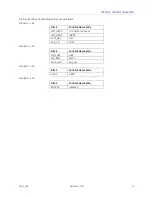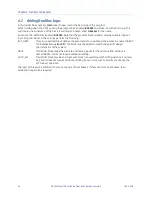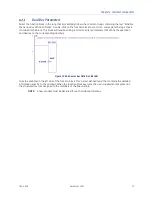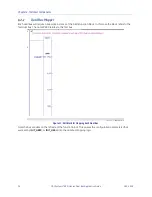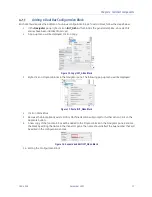
Chapter 3. Application System Architecture
8
PACSystems* RX3i Genius Dual Bus Application Guide
GFK-2928
3.1
PROFINET Network Arrangement
A ring topology using MRP is the preferred arrangement. With this topology, a system may use a combination
of PROFINET System Redundancy (PNSR) devices and non-PNSR devices (specifically Genius Communication
Gateway modules).
Also, systems may incorporate managed network switches that support MRP. The approach is particularly
useful for large systems that are upgraded incrementally. In this case, Genius dual busses (each consisting of
four GCG modules
–
Primary A & B, Secondary A & B) may be grouped into one of multiple subrings.
3.2
System and Dual Bus References
Appl. Refs
%I Addresses
Bus A
(1..8192)
App. Refs.
%AI Addresses
Bus A
(1..8192)
Hardware Status
Addresses
(16385..32767)
Input addresses for the Backup Bus B. The addresses are
offset by the constant DI_OFST (for Discrete Inputs) or
AI_OFST (for Analog Inputs)
These addresses are used by certain types of modules to
display status, diagnostics, etc. Typical modules are CPU,
Ethernet, Serial Communications, Genius bus controllers,
Genius Communications Gateway, Profinet controller, etc.
Input addresses for Bus A. These are the principal references
used in the application’s program logic.
%I Addresses
Bus B
(8193..16384)
%AI Addresses
Bus B
(8193..16384)
D
I_
O
F
S
T
A
I_
O
F
S
T
Figure 3: System and Dual Bus References
Each Genius device that has been configured to have discrete inputs must have one block of references
assigned to
Bus A
and a separate unique block of references assigned to
Bus B
. The application logic is
always solved using the references that are assigned to
Bus A
. There is fixed offset that specifies the location
of
Bus B
references relative to
Bus A
.
The references for analog inputs are configured in a similar fashion.
The offset for discrete inputs (
DI_OFST
) and the offset for analog inputs (
AI_OFST
), as shown above, are
recommended values. However, they may be configured independently for each dual bus pair.
3.3
Dual Bus Mapping Description
The dual-bus application evaluates the attachment state for each Genius device on both of the busses.
•
If the device is attached to
Bus A
, then the corresponding inputs appearing in the
A
references are
valid and no further action is needed.
•
If the Genius device is attached to
Bus B
, then the inputs appearing in the
B
reference area are
remapped (i.e., MOVed) into the
A
reference area.
•
If the Genius device is not attached to either
Bus A
or
Bus B
, then the inputs will “
Hold Last State
”
.
There are two choices for the time period that the inputs are frozen.
o
Normally, the inputs are frozen for a specified time. When the period expires, the values in
the block of references are reset to OFF or 0. The preset time may be configured
independently for each pair of dual busses.
o
Or, the alternate choice is to hold last state continuously until the device re-attaches to one
of the busses.
•
A fault message will be posted in the PLC Fault Table if a device changes its online/offline state for the
dual bus.


















